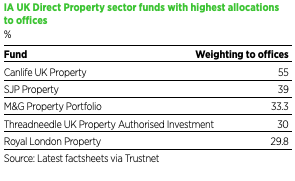So much has changed since the coronavirus pandemic emerged onto the scene early last year. Remote working, once dismissed as unfeasible, has become the norm. As economies begin to open up and lockdown restrictions ease, companies are still figuring out what their hybrid working models might be.
Legal & General Investment Management head of real estate markets research Bill Page notes that employee and employer surveys have been broadly consistent over the first 12 months since the “great experiment” of working remotely began. Workers expressed a desire to work from home two or three days a week, while most bosses planned to reduce floorspace.
But lately sentiment seems to have become more clouded.
A survey from KPMG in March pointed to a huge loss in appetite for downsizing, with just 17% of 500 global chief executives planning to cut back on offices, down from 69% in the last survey in August.
But fresh figures from PwC in June seemed to turn this notion on its head, with 258 of the UK’s major employers saying they plan to reduce office space by up to 9 million square feet, equivalent to 14 of the City of London’s ‘Walkie-Talkie’ buildings.
The big downsize
This time last year, when the outlook for the property sector was arguably even more uncertain, Portfolio Adviser reported that fund managers were standing by their office allocations.
Several daily dealing property funds, which at that point were frozen following the onslaught from the Covid crisis, had hefty exposure to City offices and regional office blocks.
Canlife UK Property had a 60% weighting to offices last June, while Aegon Property Income and Aviva Investors UK Property had 53.2% and 32.3% of their portfolios tied up in office space. The latter two are currently in the process of being wound-up.
Twelve months on and with all the other major property funds having resumed trading, managers have not changed their office allocations drastically.
Canlife UK Property, which still has the highest weighting in the IA UK Direct Property sector, has seen its exposure drop marginally to 55% after taking profits on a central London asset.

Royal London Property has 29.8% in office space, which is about the same as a year ago, while M&G Property Portfolio had a slightly higher weighting of 33.3% when it re-opened in May, up from 29.1% a year ago. However, an M&G spokesperson said this would decrease to 24% after manager Justin Upton completes the remaining sales lined up during the £1.3bn fund’s suspension.
A skewed sector
Given the huge amount of uncertainty plaguing the sector during the past year, AJ Bell head of active portfolios Ryan Hughes isn’t surprised allocations have largely remained static.
Until managers get more clarity on what companies’ post-pandemic structures will look like he thinks allocations to the sector will continue to appear skewed.
“We’ll probably get a better picture in six to nine months’ time, when maybe things are a little bit more settled. Maybe that initial wave of redemptions for investors will have eased off then and we can start judging again what sensible, longterm asset allocation to the broad commercial property market looks like.”
There’s also the fact that trading in and out of buildings can rack up huge costs for fund managers, says Quilter Cheviot research analyst Oli Creasey.
“The general assumption is that a buyer will have to pay nearly 7% of asset value in stamp duty, agent’s fees and other costs, while sellers will have external advisers to pay as well.
“While the idea of selling all office properties and buying logistics assets instead may be appealing, the reality is that unless you can expect 10% outperformance from the new asset in a reasonable time frame then the trade probably isn’t worth doing.
“This also assumes the purchase and sale occur at book value, which is far from certain in the current environment.”
The office will not become redundant
While managers may not have made wholesale changes to their office allocations, the coronavirus pandemic has forced them to re-evaluate the types of assets they own.
M&G head of real estate property research Richard Gwilliam says while he does not expect working practices to revert to how they were pre-pandemic, he doesn’t believe offices will become redundant either.
But having worked from home for so long employees will require “a more compelling reason to return to the office”, meaning spaces will need to facilitate productivity and social interaction.
“Occupiers will want to focus on high-quality space in central well-connected locations with attractive amenities, particularly if they cater for employee wellbeing and have high ESG credentials,” he says.
For this reason, the M&G Property Portfolio has “very limited exposure” to offices outside of city centres and manager Upton has been selling “riskier assets” like short income, vacancy and out-of-town offices and business parks.
As at 31 May 2021, the fund’s vacancy rate was 6.9% versus the MSCI Quarterly Property Index’s 13.6%.
L&G UK Property managers ditching offices that offer ‘less flexibility’
LGIM’s Page believes reports of “the death of the office” have been “greatly exaggerated”. “We expect utilisation – employees in on a given day – to settle at 10- 20% lower than the pre-pandemic average of about 60%,” says Page.
“This should be substantially offset by medium-term jobs growth and changes to office configuration – meaning more space per head and more collaboration space,” he adds. “Equally, we expect the flow of new supply to be held back by less construction activity and conversion into other uses.”
L&G UK Property manager Matt Jarvis says he and co-manager Michael Barrie have been disposing of assets that offer “less flexibility” or “where the costs of creating a vibrant and engaging workspace relevant to occupiers in the post-Covid era have not been reflected by the market”. A recent example is the sale of One Colmore Square in Birmingham.
Page also expects to see “a flight to quality”, with occupiers shunning “weaker quality spaces in fringe locations” for those that create “vibrant and healthy workspaces”, focusing on indoor environmental quality and wider ESG credentials such as energy performance.
According to Jarvis, he and Barrie have been adding to existing holdings like new development One Victoria Street in Windsor and 120 Aldersgate Street, near the Barbican in London. He also expects to commit further capital in the short term to major refurbishment schemes at Quayside in Bristol and enhancement work at Hodge House in Cardiff .
Looking beyond London
While property managers have been taking stock of their portfolios, many have been ditching regional assets.
L&G UK Property’s exposure to offices is down from 28% at the start of 2020 to 19% at the end of May 2021, mostly down to disposals outside London. These now make up 19% of the portfolio versus 23% previously.
Standard Life Investments and Canada Life Asset Management told Portfolio Adviser they were favouring properties in the south-east.
Gerry Frewin, manager of the Threadneedle UK Property Authorised Investment Fund, also prefers a “south-centric approach” with a focus on “mis-priced assets in heavily supply-constrained markets”. Frewin has no central London exposure whatsoever.
Though London office values have held up comparatively better than their regional counterparts, Creasey says at this stage it is too early to tell whether this will influence fund managers’ allocations.
He says: “The demand for London versus regional office space depends on who the tenant is. A large US investment bank may consider trimming its UK footprint but is likely to retain a London office. The city is still the first choice for a European HQ.
“However, the advantage for regional offices is that their location can make them easier to occupy in a post-Covid world. Staff commutes are more likely to be shorter and car-based compared with the typical London commute.”










